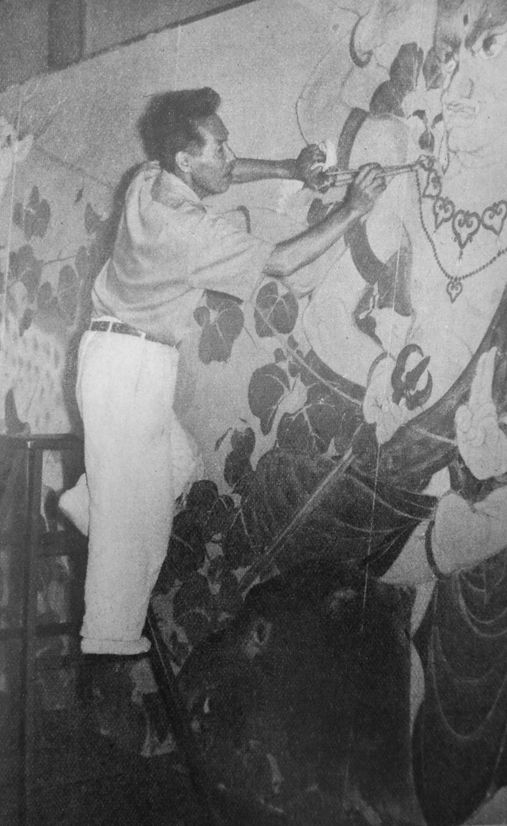| |
KAWABATA Ryushi
|
|
Artist – KAWABATA Ryushi (Ryuko)
(川端龍子, かわばたりゅうし) was born on June 6 in 1885 as KAWABATA
Shōtarō (川端 昇太郎) in
Wakayama Prefecture (和歌山県) in
Wakayama City (和歌山市). During his childhood he was also been
called Ryoku or Tatsuko, both written "龍子" but spoken in different reading.
He was a Japanese painter in both the Nihonga and Yoga style, as well as a
haiku poet. Ryuko was a
member of the "Hototogisu" literary
cycle, like his younger
half-brother KAWABATA Bosha, a still known haiku poet. Together with Taikan Yokoyama ( 横山 大観) and
Gyokudo Kawai ((川合 玉堂),
he is known as one of the three
masters of modern Japanese painting.
His family moved to Tokyo in 1895 when he was 11 years old. He dropped out of junior high school in 1904 and studied Western painting at the Aoibashi Western Painting Research Institute (Aoibashi yōga kenkyūjo, 葵橋洋画研究所) and the Taiheiyo Gakai Research Institute (Taiheiyō gakai kenkyūjo, 太平洋画会研究所). He worked for Kokumin Shimbun newspaper (Kokumin shinbun, 国民新聞) and other media, and became known for his illustrations. In 1913 at the age of 28, he traveled to the United States, where he was very disappointed, that nobdy was interested in a Japanese, painting in western style. Back in his coutry of origin, he turned to Japanese painting in the yoga style. At first he joined the Museikai Society or 'Silent Society' (无声会), devoted to naturalism.
In 1915 after the dissolution of Musekai, he formed the Sangokai or 'Coral' Society' ('珊瑚会') together with with Hyakusui Hirafuku (平 福百穂) and others, somehow devoted to fusing naturalism and classics. In the same year, the iconic 'Path of the Fox' ('Kitsune no Wataru','狐の径 ') was selected for the revival of the Japan Art Institute Exhibition (日本美術院展). In the following year, 'Origin of the Miraculous Spring' ('Reisen Yura', '霊泉由来') won the prestigious Chogyu Prize (樗牛賞). However, his bold expressions soon came to be seen as heresy, and he withdrew from the art academy in 1928. In the following year, he founded Seiryu-sha Society or 'Blue Dragon Society' (青龍社) and painting schol together with the Mikata Juku (御形塾), advocating the art of the venue and being bold. He created a style rich in dynamism, often changing to large formats. He was appointed a member of the Imperial Art Academy in 1935, but declined the following year. He received the "Order of Culture" in 1959. In 1962, to commemorate the 35th anniversary of the founding of Seiryu-sha, he built the Ryushi Memorial Hall (Seiryu-sha Ryushi Memorial Hall, Chuo 4-2-1, Ota-ku, Tokyo) in his residence and exhibited his works. His representative works include " Naruto" ("(鳴門"), "Pearl", "Shinju no Kyoku" and "Shiozai". He is also familiar with haiku and has written a collection of haiku.
Despite being called a maverick, KAWABATA Ryuko continued to challenge Japanese paintings with large canvases, bold compositions, and vivid colors. He is a popular painter with many exhibitions held even today, and his works still give new impressions to those who see them, in keeping with the spirit of “venue art” ("Kaijō geijutsu", "会場芸術") advocated by 'Tatsuko'.
Personal
life - He was born into a well-off family. His
father being of Samurai descent, being part of the editorial
cycle of Kokumin Shimbun newspaper. KAWABATA Ryushi was
married and had at least two daughters and three sons. The
eldest son and second daughter died before the war. In 1941, his
third son died on the battlefield during the war. His wife died
on July 17, 1944 . KAWABATA Ryushi died on April 10, 1966.
Seiryu-sha
society dissolved after Ryuko's death and his home in
the Ota Ward became a museum.
Aliases - none
Disciples - none known
Copyright 2008 ff: Hans P. Boehme
